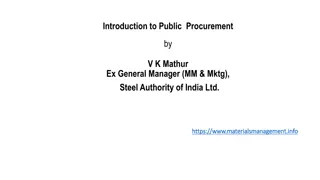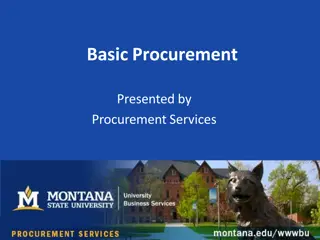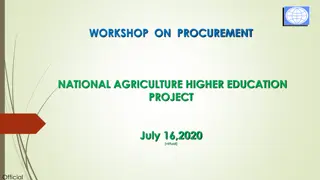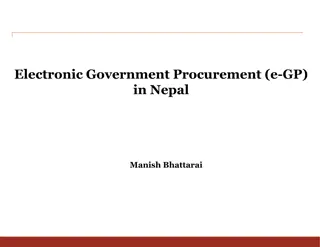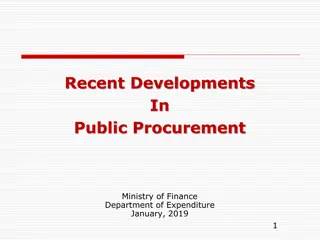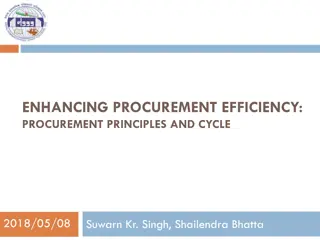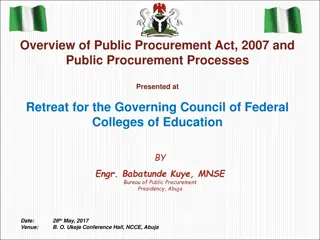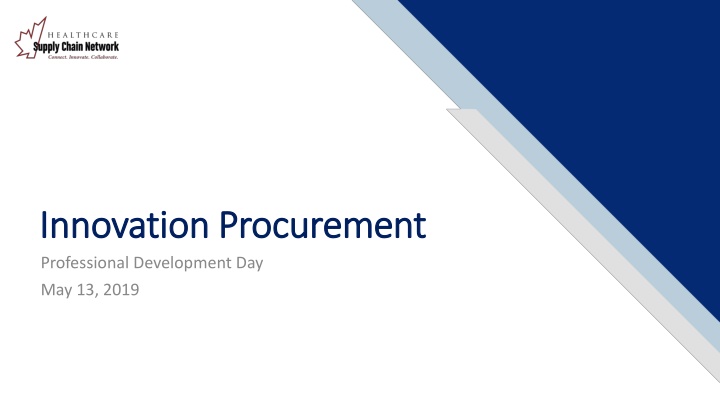
Innovation Procurement Professional Development Workshop Agenda
Gain insights into innovation procurement with experienced facilitators Sarah Friesen and Iris Ko. Join the workshop on May 13, 2019, to explore topics like problem statement development, market engagement strategies, outcome-based procurement, and value-based evaluations. Enhance your knowledge and skills in healthcare procurement solutions and strategic sourcing transformation.
Download Presentation

Please find below an Image/Link to download the presentation.
The content on the website is provided AS IS for your information and personal use only. It may not be sold, licensed, or shared on other websites without obtaining consent from the author. If you encounter any issues during the download, it is possible that the publisher has removed the file from their server.
You are allowed to download the files provided on this website for personal or commercial use, subject to the condition that they are used lawfully. All files are the property of their respective owners.
The content on the website is provided AS IS for your information and personal use only. It may not be sold, licensed, or shared on other websites without obtaining consent from the author.
E N D
Presentation Transcript
Innovation Procurement Innovation Procurement Professional Development Day May 13, 2019
Introductions and Overview Introductions and Overview
Session Facilitator Session Facilitator Sarah Friesen leads Friesen Concepts Inc., an independent practice specializing in healthcare procurement solutions. Areas of focus include strategic sourcing transformation, innovation procurement and professional development. Sarah has almost 20 years of experience in the healthcare sector, and she brings 17 years of strategic sourcing and supply chain experience from the private sector. Sarah supports healthcare organizations as they navigate the complexities of innovation procurement initiatives. Sarah is a founding member of HSCN, and most recently was the Project Manager for the Innovation Procurement Toolkit Expansion project. She participates in various innovation initiatives, served as a member of the Ontario Health Innovation Council, and lectures on healthcare supply chain topics at various educational institutions and industry forums. Sarah Friesen Friesen Concepts Inc.
Session Facilitator Session Facilitator Iris Ko is currently a Professor at Georgian College, teaching postgraduates on research planning and project Management skills. From 2005-15, Ms. Ko was the Strategic Policy and Innovation Director at the Ontario Public Services. In this role Ms. Ko led the development of the Broader Public Sector Procurement Directive and the innovation procurement strategy for Ontario to incentivize innovation development and adoption. She established funding programs to accelerate the culture shift to value-based procurement which was recognized by the Ontario Health Innovation Council, launched the Operating Room Supply Chain pilot program and other back office transformation initiatives within the health and education sector. Iris Ko Independent, Professor Ms. Ko has a proven track record in excellence and delivery, and was invited as a conference speaker on procurement, innovation and transformation strategies internationally.
Workshop Agenda Workshop Agenda Time Topics 9:00 9:15 Welcome and Introductions Overview: Innovation Procurement 9:15 10:00 Introduction: Innovation Procurement Toolkit and Innovation Procurement Models 10:00 10:15 10:15 10:45 Developing the Problem Statement Scenario: Developing the Problem Statement 10:45 11:00 Break 11:00 11:15 Scenario: Developing the Problem Statement - Debrief Early Market Engagement Strategies Market Sounding Market Consultations 11:15 12:15 12:15 1:00 Lunch 1:00 1:45 Scenario: Preparing for Market Sounding/Consultation Outcome Based Procurement 1:45 2:15 Value Based Evaluations 2:15 2:30 Break 2:30 3:45 Scenario: Outcome Based Procurement and Value Based Evaluations 3:45 4:00 Wrap Up
Introduction to Introduction to Innovation Procurement Innovation Procurement
What is Value What is Value- -Based Procurement? Based Procurement? Value-based healthcare is a framework for achieving better outcomes that matter to patients, optimizing the cost of care delivery to the health system Formulae developed by Professor Michael Porter and others define value as the outcomes that matter to patients divided by the cost to deliver this care Value-based procurement is a strategic enabler of value-based healthcare the product/service that performs best, providing the highest measurable quality outcome relative to need at the lowest cost, is the product/service offering the highest relative value Increasing focus on value-based procurement, which enables evaluation of a broader range of value through an emphasis on outcomes
Evolution to Value Evolution to Value- -Based Procurement Based Procurement Good procurement practices ensure publicly funded goods and services are acquired in a fair, open and transparent manner Public procurement in Canada must align with Relevant trade agreements such as the Canadian Free Trade Agreement (CFTA) and CETA Provincial legislation or requirements (e.g., Ontario BPS Procurement Directive) Most traditional RFP processes are structured to focus on value, with a high scoring component for clinical requirements, based on known specifications In reality, differential on rated criteria can be narrow, so price determines the outcome Leveraging learnings from other jurisdictions, processes are beginning to evolve: Innovation as an enabler Outcome based specifications Value based evaluation criteria 8
What is Innovation Procurement? What is Innovation Procurement? the purchase of solutions that do not exist in the market, or need to be adapted or improved to meet specified needs and create value for users and the procuring organization (MGCS: BPS Primer on Innovation Procurement (Interim)) When the potential exists for varied and various solutions to a stated problem, traditional specifications are typically inadequate The procuring organization must focus on the value the solution can bring, based on the desired outcomes Thus innovation procurement models become enablers of value-based procurement This requires new methodologies and approaches to procurement, and the development of new skills to manage the complexity
Broader Public Sector Procurement Broader Public Sector Procurement Processes Processes BPS organizations owe general fairness duties, arising out of: the Broader Public Sector Procurement Directive trade treaties In addition, BPS organizations may find that their procurements fall within the Contract A/B paradigm If a Contract A/B process arises, a purchasing organization has a contractual relationship with bidders regarding how the competitive process will unfold. Under Contract A , the purchasing organization: must reject non-compliant bids must comply with the stated rules of the process owes compliant bidders implied fairness duties That process contract is separate from Contract B , which is the awarded contract: Included with the RFP and often a mandatory requirement for proponents to accept stated T&C s Signed with successful bidder Governs the ongoing purchase of equipment/goods/services from the successful bidder
Why is Innovation Procurement Different? Why is Innovation Procurement Different? The traditional Contract A/B process is rigid and adds more stringent fairness considerations; for example, it is not suited to negotiation or dialogue with the vendors to further refine the requirements Innovation procurement often requires a nimble process, which may include consultations This arises because of the need to work with potential bidders to understand market capabilities, and to inform OBS and value-based evaluation criteria The IPT RFS Template is designed to avoid or minimize the potential that a Contract A process will arise In conjunction with the Innovation Procurement Models Guide it lays out the considerations for procurement processes such as competitive dialogue Care must be taken in using the templates to avoid inserting irrevocability clauses and other bidder hurdles that could result in Contract A, exposing the organization to greater risk by creating a rigid process
When to use Innovation Procurement? EXAMPLE: Innovation Procurement Decision Tree * The following are circumstances in which innovation procurement may be preferred to traditional procurement practices: 1. When there is no existing solution in the market 2. When needs cannot be met without significant modifications to existing solutions 3. When looking for alternative approaches 4. When the solution is complex and involves multiple stakeholders 5. When the value of procurement is high enough to justify the time and resources 6. When collaboration and partnership with suppliers in solution development may be required 7. When the solution cannot be objectively defined 8. When the technical specifications cannot be established with sufficient precision Assess Need and develop problem and/oroutcomes statement PerformPreliminary MarketAnalysis BPS Primer on Innovation Procurement (interim) Can the needs can be easily satisfied?* Engage in Early MarketEngagement Yes No Will this result in procurementof a solution? ProcureSolution Yes No Optionsinclude: Innovation Partnership Design Contest Competitive Dialogue Competitive Procedurewith Negotiation Innovation Friendly Procurement RunProcurement ProcureR&D Services OptionsInclude: TraditionalProcurement Competitive Procedure with Negotiation Innovation Friendly Procurement Manage Agreement Stop Procurement process (maycontinue in house) Yes Assess Design/ Prototype No Will thisresult in procurement ofa solution? ManageAgreement
The Value of Innovation Procurement The Value of Innovation Procurement Best fit-for-purpose solutions Access to public sector clients Reductions in wait times Opportunity to apply research, testing and commercialize ideas Better diagnosis Support for small and medium-sized enterprises Higher levels of end user satisfaction Healthcare Sector Supplier Potential total cost of ownership reduction Opportunity to develop new markets Society Improvements in patient outcomes and quality of life
Where Do Ideas Come From? Where Do Ideas Come From? Healthcare Service Providers Researchers Patient Advocate Patient Caregivers & Family Family Health Teams Suppliers & Industry Associations Clinicians Government
15 Innovation Procurement in Action Innovation Procurement in Action There are an increasing number of initiatives underway across the country facilitating the adoption of innovative solutions through innovation procurement Share some of your experiences with managing innovation procurement initiatives
The Innovation Procurement Toolkit (IPT) The Innovation Procurement Toolkit (IPT)
Supporting Tools are Critical Supporting Tools are Critical Rapid advancement of new technologies and solutions in Canadian healthcare has resulted in heightened awareness of the impact innovative technologies have on patient outcomes The Healthcare Supply Chain Network (HSCN) has developed an Innovation Procurement Toolkit (IPT) aligned with the Ontario Ministry of Government and Consumer Services (MGCS) BPS Primer on Innovation Procurement (interim) (the Primer) The Primer was developed in the context of MGCS s Innovation Procurement Initiative to provide guidance on planning, designing and implementing innovation procurement and includes Overall guidance on innovation procurement 7 early market engagement strategies 6 innovation procurement models The HSCN Innovation Procurement Toolkit does not repeat the processes delineated in the Primer but rather includes Tools and templates to help manage innovation procurement initiatives Guidance documents to support processes described in the Primer
Notes about the Toolkit Notes about the Toolkit This toolkit is a compendium of resource tools designed to assist Health Service Providers in developing competitive procurement processes for innovative solutions It is intended as a general reference, with commentary on issues and options with various innovation procurement models and features supplemented by specific guidance embedded in the associated templates The toolkit (and the accompanying templates) does not replace your organization s own procurement policies and processes All processes detailed in the toolkit are compliant with the BPS Procurement Directive Sources for all documents in the Toolkit are posted in an Appendix on the HSCN website These include examples of how organizations in various jurisdictions have executed early market engagement strategies and innovation procurement initiatives, with their lessons learned and supporting documents The toolkit is intended to be a dynamic document and will be updated over time
Innovation Procurement Toolkit: Navigation Guide Engage Market1 Procure Solution2 Assess Need Award Contract Manage Contract 1. 2. R&D Services Agreement Template RFPQ Template (optional) Market Sounding R&D Procurement RFS Template Innovation Agreement Template RFPQ Template (optional) Market Creation Innovation Partnership RFS Template RFEI Template Outcome Based Specifications Guide Market Engagement Prospectus Innovation Procurement Models Guide Innovation Agreement or CTC Template3 Reverse Trade Show RFPQ Template (optional) Design Contest RFS Template Manage Contract Early Market Engagement Guide Questionnaire Value Based Evaluation Criteria Guide Market Consultation Assess Need Innovation Agreement or CTC Template3 Written Submissions Trade Show Competitive Dialogue RFPQ Template RFS Template Total Cost of Ownership Guide Online Platform Notice to Suppliers Request for Expression of Interest Innovation Agreement or CTC Template3 RFPQ Template (optional) Negotiation RFS Template Notice of Intended Procurement Innovation Agreement or CTC Template3 Forward Innovation-Friendly Procurement RFPQ Template (optional) RFS Template Procurement Plan Unsolicited Proposal 1 Consult the Interim BPS Primer on Innovation Procurement for a description of Early Market Engagement Strategies. 2 Consult the Interim BPS Primer on Innovation Procurement for a description of Innovation Procurement Models. 3 See the HSCN Common Tendering and Contracting Templates: the Equipment Purchase & Installation Agreement Template, the Goods Supply Agreement Template, or the Services Agreement Template.
Innovation Procurement Models Innovation Procurement Models Intention to Procure beyond Prototype Solution Exists in Market Model Definition The process of purchasing research and development (R&D) of new and sometimes radically different solutions R&D No No Innovation Partnership The process of entering into a partnership with selected supplier(s) to research, develop and purchase an innovative solution(s) to meet an identified need Maybe but needs modification Yes A process in which participants submit design proposals and/or product prototypes to compete for an award Design Contest No Maybe A process that allows the procuring organization to thoroughly discuss each aspect of the procurement with suppliers prior to specifying the requirements and prior to an invitation to submit their full and final proposals A process to solve complex needs when there are existing innovative solutions in the market and there is some flexibility on the requirements that allow for negotiations between the buyer and seller. Unlike competitive dialogue, it requires that the procuring organization be able to specify the desired characteristics of the goods or services in advance of the competition. Competitive Dialogue Maybe but needs modification Yes Competitive Procedure with Negotiation Yes Yes Innovation Friendly Competitive Process Outcome-based models that are used in such a way that innovative solutions are not excluded or treated unfairly during a competitive procurement process Yes Yes Source: MGCS BPS Primer on Innovation Procurement (interim)
Choosing the Innovation Procurement Model Choosing the Innovation Procurement Model It is important to begin an innovation procurement process by first gathering and considering background and other information Initiating an innovation procurement process without sufficient background research presents the risk that the procurement process may not fit what is being procured Research will help establish parameters when the solution is difficult to describe there are a variety of approaches across possible solutions subsequent stages of development, design, testing, and proof of concept are to be determined A general understanding of the context, issues, needs and basic parameters is needed in order to have a coherent competitive process consider a wide range of methods of gathering information including early market engagement
Key Considerations in Innovation Procurement Key Considerations in Innovation Procurement There are factors that must be consistently considered for all innovation procurement models, e.g. Intellectual Property existing intellectual property customizations to existing intellectual property entirely new intellectual property Risk and Reward The allocation of risk between the parties Generally, risks should be allocated to the party that can best manage and mitigate that risk Moving away from an allocation that puts more risk on the supplier can be an effective incentive to supplier participation in innovation procurement Pricing and Payment Pricing may be a significant unknown when it comes to innovation procurement This may lead to over-budget proposals or to vastly divergent approaches to fees and payment
Using the RFPQ and RFS Templates Using the RFPQ and RFS Templates Request for Pre-Qualification (RFPQ) The RFPQ Template can be used to qualify proponents to participate in any of the innovation procurement models and in particular, can be used to facilitate the Competitive Dialogue model Request for Solution (RFS) The RFS Template can support any of the innovation procurement models The template incorporates colour-coded guidance for each of the procurement models discussed in the Primer shaded in the colour corresponding to the Navigation Guide
Needs Assessment: Needs Assessment: Developing the Problem Statement Developing the Problem Statement
Innovation Procurement Toolkit: Navigation Guide Engage Market1 Procure Solution2 Assess Need Award Contract Manage Contract 1. 2. R&D Services Agreement Template RFPQ Template (optional) Market Sounding R&D Procurement RFS Template Innovation Agreement Template RFPQ Template (optional) Market Creation Innovation Partnership RFS Template RFEI Template Outcome Based Specifications Guide Market Engagement Prospectus Innovation Procurement Models Guide Innovation Agreement or CTC Template3 Reverse Trade Show RFPQ Template (optional) Design Contest RFS Template Manage Contract Early Market Engagement Guide Questionnaire Value Based Evaluation Criteria Guide Market Consultation Assess Need Innovation Agreement or CTC Template3 Written Submissions Trade Show Competitive Dialogue RFPQ Template RFS Template Total Cost of Ownership Guide Online Platform Notice to Suppliers Request for Expression of Interest Innovation Agreement or CTC Template3 RFPQ Template (optional) Negotiation RFS Template Notice of Intended Procurement Innovation Agreement or CTC Template3 Forward Innovation-Friendly Procurement RFPQ Template (optional) RFS Template Procurement Plan Unsolicited Proposal 1 Consult the Interim BPS Primer on Innovation Procurement for a description of Early Market Engagement Strategies. 2 Consult the Interim BPS Primer on Innovation Procurement for a description of Innovation Procurement Models. 3 See the HSCN Common Tendering and Contracting Templates: the Equipment Purchase & Installation Agreement Template, the Goods Supply Agreement Template, or the Services Agreement Template.
Needs Assessment: the First Step Needs Assessment: the First Step Needs assessment identifies and validates the requirements of the end user It is the necessary first step whether the sourcing initiative is traditional or uses an innovation procurement approach Through this process we seek to identify and validate information relating to the products, services or technology under consideration (traditional procurement) or to the problem and desired outcomes (innovation procurement) Stakeholders will include all those individuals or departments whose work will be impacted by the outcome of the procurement initiative Needs assessment is critical to the development of the problem statement
Problem Statement Problem Statement The problem statement should describe the problem, not the preferred solution Facts presented in the problem statement must be relevant and compelling Include metrics if they are available Engage key stakeholders and subject matter experts (SME) from the beginning, to ensure the requirements and/or objectives are properly defined all stakeholders impacted by this initiative are engaged in the process Core stakeholders should form the project team, and be a consistent part of the process, from development of the problem statement to final review of the information collected Gather key facts and then draft a statement, using the following methodology as a guide
Developing the Problem Statement: the 5 Ws Developing the Problem Statement: the 5 W s Element Question Key Facts What What is the problem? Who does this problem impact? Clinicians/technicians/patients? Who When is this problem occurring? In the present? Future? Both? When Where Where is the problem occurring? What is the impact/consequence of not solving this problem? Why
Development of the Problem Statement Development of the Problem Statement Seniors aren t taking their medications when they should and end up in hospital.
Development of the Problem Statement Development of the Problem Statement Seniors with mild cognitive impairment often forget to take their medication and have adverse events including falls, leading to potential hospitalization. The problem will continue if a solution is not found to increase compliance with taking medications as prescribed. The consequences of not addressing this problem include the impact on quality of life for the seniors and the burden of care on the healthcare organizations.
Development of the Problem Statement Development of the Problem Statement Seniors living independently, with mild cognitive impairment, often forget to take their medication and have adverse events including falls, leading to visits to the Emergency Department (ED) and potential hospitalization (1000 visits in 2017 at Downtown HSC alone). This impacts the seniors themselves, as well as family/caregivers, ED staff and other patients waiting in ED (among others). The problem is current and will continue if a solution is not found to increase compliance with taking medications as prescribed among these independent seniors who are aging in place at home. At the moment, the compliance level is less than 40%. The consequences of not addressing this often- preventable problem include the impact on quality of life for the seniors and the burden of care on the healthcare organizations. All examples are works of fiction, and any resemblance to projects living or dead is purely coincidental.
Scenario Developing the Problem Statement Developing the Problem Statement (30 minutes) (30 minutes)
Break Break
Scenario Developing the Problem Statement: Developing the Problem Statement: Debrief Debrief
Early Market Early Market Engagement Strategies Engagement Strategies
Innovation Procurement Toolkit: Navigation Guide Engage Market1 Procure Solution2 Assess Need Award Contract Manage Contract 1. 2. R&D Services Agreement Template RFPQ Template (optional) Market Sounding R&D Procurement RFS Template Innovation Agreement Template RFPQ Template (optional) Market Creation Innovation Partnership RFS Template RFEI Template Outcome Based Specifications Guide Market Engagement Prospectus Innovation Procurement Models Guide Innovation Agreement or CTC Template3 Reverse Trade Show RFPQ Template (optional) Design Contest RFS Template Manage Contract Early Market Engagement Guide Questionnaire Value Based Evaluation Criteria Guide Market Consultation Assess Need Innovation Agreement or CTC Template3 Written Submissions Trade Show Competitive Dialogue RFPQ Template RFS Template Total Cost of Ownership Guide Online Platform Notice to Suppliers Request for Expression of Interest Innovation Agreement or CTC Template3 RFPQ Template (optional) Negotiation RFS Template Notice of Intended Procurement Innovation Agreement or CTC Template3 Forward Innovation-Friendly Procurement RFPQ Template (optional) RFS Template Procurement Plan Unsolicited Proposal 1 Consult the Interim BPS Primer on Innovation Procurement for a description of Early Market Engagement Strategies. 2 Consult the Interim BPS Primer on Innovation Procurement for a description of Innovation Procurement Models. 3 See the HSCN Common Tendering and Contracting Templates: the Equipment Purchase & Installation Agreement Template, the Goods Supply Agreement Template, or the Services Agreement Template.
Early Market Engagement Strategies Guide Early Market Engagement Strategies Guide Traditional market analysis, where the supplier base, markets and products or services are well known and understood, doesn t typically work when the solution is unknown Early Market Engagement (EME) helps us gather intelligence that will inform our procurement process and ensure the optimal solution is identified to solve the stated problem and achieve the desired outcomes The EME strategy informs the way forward, and may lead to a traditional procurement or no procurement at all, depending on what is learned from the exercise The Early Market Engagement (EME) Strategies guide provides an overview of the seven strategies described in the Primer It does not repeat the processes laid out in the Primer, but highlights activities associated with those processes
Early Market Engagement Strategies Early Market Engagement Strategies Strategy Definition Intended Outcomes Define achievable requirements A defined consultation process to assess the reaction of the market to a need Market Sounding Increase supplier readiness to respond to procuring needs Identify new supplier offerings A process intended to generate interest in the supplier community to compete for future procurement opportunities Market Creation Increase market competition Events driven by Broader Public Sector (BPS) organizations to encourage new and existing suppliers to consider doing business with the BPS A process which allows BPS organizations to gather information about supplier capabilities, qualifications, and interest in a specific procurement opportunity The process of giving suppliers advance notice about the BPS organization s upcoming procurement opportunities Events that allow suppliers in a specific industry to showcase and demonstrate their latest products, market trends, and opportunities that might be relevant to BPS organization s needs Proposals submitted by suppliers to address a BPS organization s current or future needs that may or may not have been identified by the organization Stimulate new interest to consider doing business with the BPS Reverse Trade Show Request for Expressions of Interest (RFEI) Understand market capacity and interest Forward Procurement Plan ( FPP ) Increase supplier readiness to respond to BPS needs Trade Shows Understand the innovative market offerings Reframe need for future procurement opportunities Unsolicited Proposals Source: MGCS BPS Primer on Innovation Procurement (interim)
Stakeholder Engagement Stakeholder Engagement It is critical to engage stakeholders early in the process to provide education and secure buy-in The process will be more impactful if key stakeholders (roles will vary depending on the procurement) form the project team at the beginning and play a role in executing the strategies This creates organizational alignment and sends a powerful signal to the supplier community Engage with other HSPs and/or Shared Services Organizations (SSO) to determine whether they are exploring similar opportunities Consult with trade associations in certain solution spaces, and include them in planning EME strategies, to get reaction and advice and/or to attend sessions as objective observers for the supplier community Learn from the experience of others!! Involve the entire project team in this process as a team building exercise and to build excitement
Using the Intelligence Wisely Using the Intelligence Wisely There must be a process in place to review the inputs from the market and summarize the findings that will inform any subsequent competitive initiative This process should be identified at the outset, to ensure information is properly collected and documented throughout It is optimal to assign one individual to collate the information and draft a report, soliciting input from internal SMEs and other relevant stakeholders as necessary This report will enable the identification of the best procurement option and the development of procurement documents with the most up to date and relevant information Every EME initiative is a learning opportunity from a process perspective apply those learnings to improve the execution of future EME strategies and associated innovation procurements
Innovation Procurement Toolkit: NavigationGuide EngageMarket1 Procure Solution2 AssessNeed Award Contract ManageContract 1. 2. R&DServices Agreement Template RFPQTemplate (optional) MarketSounding RFS Template R&DProcurement Innovation Agreement Template RFPQTemplate (optional) MarketCreation RFS Template InnovationPartnership RFEI Template Outcome Based Specifications Guide Innovation Procurement Models Guide Market Engagement Prospectus Innovation Agreement or CTCTemplate3 ReverseTrade Show RFPQTemplate (optional) RFS Template DesignContest ManageContract Early Market EngagementGuide Questionnaire Value Based Evaluation CriteriaGuide Market Consultation AssessNeed Innovation Agreement or CTCTemplate3 Written Submissions TradeShow RFPQ Template RFS Template Competitive Dialogue Total Costof Ownership Guide Online Platform Request for Expressionof Interest Innovation Agreement or CTCTemplate3 Noticeto Suppliers RFPQTemplate (optional) RFS Template Negotiation Notice of Intended Procurement Innovation Agreement or CTCTemplate3 Forward RFPQTemplate (optional) Innovation- Friendly Procurement RFS Template ProcurementPlan Unsolicited Proposal 1 Consult the Interim BPS Primer on Innovation Procurement for a description of Early Market EngagementStrategies. 2 Consult the Interim BPS Primer on Innovation Procurement for a description of Innovation ProcurementModels. 3See the HSCN CommonTenderingand ContractingTemplates:the EquipmentPurchase& InstallationAgreement Template,the GoodsSupplyAgreement Template,or the ServicesAgreementTemplate.
Early Market Engagement Strategies: Activities Early Market Engagement Strategies: Activities Notice of Procurement Written Submissions Market Consultation Market Engagement Notice to Suppliers Online Platform Questionnaire Prospectus Strategy Market Sounding X X X X X X Market Creation X X X X X X Reverse Tradeshow X Request for Expression of Interest X X X X Forward Procurement Plan X Tradeshow X Unsolicited Proposal X X
EME Activities EME Activities Questionnaire Collects information to inform a market consultation or future procurements Should not be formally evaluated when received Tailor depending on strategy Written Submission May be in response to any of the EME strategies Online Platform Dedicated online platform to enable collection of materials related to market research and needs assessment Suppliers can upload questionnaire responses and information on their innovative products and services Good site for posting dialogue summaries and Q&A Notice to Suppliers Notification of upcoming release of prospectus/RFPQ/RFS Notice of Procurement Only activity for Forward Procurement Plan Gives advance notice to the market of its intention to engage in future procurement activities Engages the market, generates interest and potentially allows suppliers to form consortia
Market Sounding Market Sounding
Market Sounding Market Sounding Definition A defined consultation process to assess the reaction of the market to a need Intended Outcomes Define achievable requirements Assess and increase supplier readiness to respond to procuring needs When to use to signal an upcoming procurement opportunity to potential suppliers and provide information about BPS needs; to identify potential suppliers and establish key contacts; to validate needs, project objectives, and the business case; to gather information to help define/refine needs in terms of feasibility and financial viability; to assess the market s capacity and maturity to address BPS needs; to assess the feasibility of the business model; to assess project complexity and develop realistic timeframes; and to accurately estimate the required budget for a particular contract MGCS BPS Primer on Innovation Procurement (interim)
Early Market Engagement Strategies: Activities Early Market Engagement Strategies: Activities Notice of Procurement Written Submissions Market Consultation Market Engagement Notice to Suppliers Online Platform Questionnaire Prospectus Strategy Market Sounding X X X X X X Market Creation X X X X X X Reverse Tradeshow X Request for Expression of Interest X X X X Forward Procurement Plan X Tradeshow X Unsolicited Proposal X X
Market Sounding: Call for Innovative Solutions Template Market Sounding: Call for Innovative Solutions Template As part of Market Sounding, a prospectus (Innovative Solutions Template) may be issued to generate interest initiate a dialogue with relevant stakeholders solicit information lay out the process/steps that will be followed This is not a call for tenders or a pre-qualification exercise! Identify and engage key stakeholders before issuing the prospectus, to ensure internal alignment on the nature of the problem and of the market sounding objectives Precede the prospectus with a notice to suppliers to signal the opportunity and lay out the steps The prospectus may include a questionnaire seeking additional input from suppliers an invitation to a market consultation exercise Do not underestimate the time required to properly complete a market sounding exercise!
Market Sounding vs. RFEI Market Sounding vs. RFEI There is sometimes confusion about the different types of EME strategies, e.g. market sounding vs. RFEI By definition the RFEI is a process which gathers information about supplier capabilities, qualifications, and interest in a specific procurement opportunity The questionnaire associated with an RFEI may also try to gauge potential pricing If you have a clear idea of what your needs are, then RFEI activities will provide information that support the development of the formal procurement process and tendering document Market sounding, on the other hand is used to generate interest, gather collective input from the market and potentially to initiate dialogue with the supplier community It is not to understand an individual supplier s capacity and offerings Market sounding is best deployed when the purchasing organization is still at the visioning stage, and may ask whether information as presented in the prospectus is feasible and achievable
Market Consultations Market Consultations & Dialogue with the Market & Dialogue with the Market
Overview of Market Consultation Overview of Market Consultation Market consultation sessions may be part of the strategy for Market Sounding, Market Creation or an RFEI These sessions generate excitement in the market provide information about the project educate suppliers on the process and most importantly, engage in dialogue with suppliers and other external stakeholders The European Commission suggests starting a dialogue with the market from the beginning Market consultations may be open sessions with many suppliers in one room, or one on one commercially confidential meetings ( CCM ) There is no prescribed format for these sessions


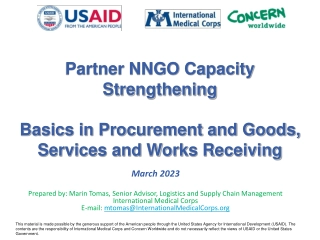

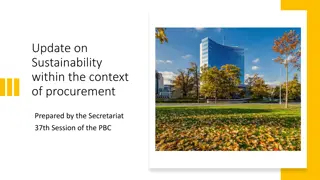



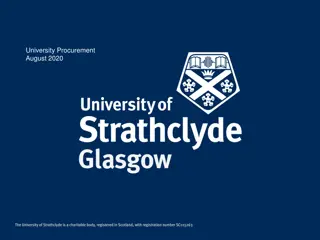
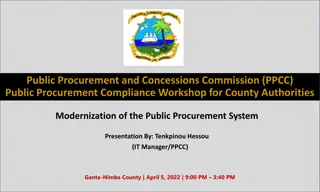
![Comprehensive Overview of Corruption Watch Submission on Public Procurement Bill [B18B-2023]](/thumb/138344/comprehensive-overview-of-corruption-watch-submission-on-public-procurement-bill-b18b-2023.jpg)
